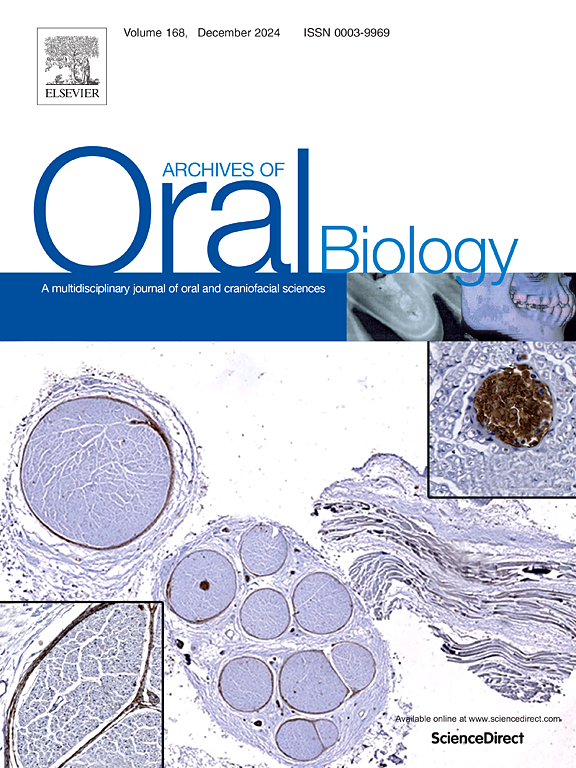omega-3和omega-6脂肪酸对小鼠舌口腔上皮发育不良肿瘤抑制通路的影响
IF 2.1
4区 医学
Q2 DENTISTRY, ORAL SURGERY & MEDICINE
引用次数: 0
摘要
目的探讨多不饱和脂肪酸omega-3和omega-6在舌上皮发育不良实验模型中对TP53和特异性primiRNAs 34 b/c表达的调节作用。将设计balb /c小鼠分为富含omega-3的鱼油组和富含omega-6的玉米油组。在丙酮中加入0.5% %的7,12-二甲基苯并蒽(DMBA)溶液,产生舌发育不良。牺牲后,评估动物的omega-6和omega-3, TP53/Ki67免疫染色,Trp53R270H突变和primiRNA 34 b/c表达。结果饲喂omega-6的小鼠发育不良率和Ki67免疫染色率高于饲喂富含omega-3的小鼠。此外,喂食富含omega-6的玉米油的小鼠,其舌组织细胞膜中花生四烯酸的平均值显著高于喂食富含omega-3的鱼油的小鼠,其舌组织细胞膜中生态五烯酸和二十二碳己酸的平均值显著高于喂食富含omega-3的鱼油的小鼠。在饲喂富含omega-6的玉米油的动物中,primiRNA-34 b/c在第90天上调。结论膳食脂质影响dmba诱导的小鼠舌癌前病变的发生;因此,低摄入富含omega-6的油,高摄入omega-3可以预防类似粘膜发育不良的特征,这可能是一种重要的预防策略。本文章由计算机程序翻译,如有差异,请以英文原文为准。
Effect of omega-3 and omega-6 fatty acids on tumor suppressor pathways in mice tongue oral epithelial dysplasia
Objective
This work aimed to evaluate the modulating effect of polyunsaturated fatty acids omega-3 and omega-6 on the expression of TP53 and specific primiRNAs 34 b/c in the development of premalignant characteristics in tongue epithelial dysplasias in-vivo experimental models
Design
BALB/c mice were divided into two diet groups: fish oil rich in omega-3 and corn oil rich in omega-6. Tongue dysplasia was generated by applying a 0.5 % solution of 7,12-dimethylbenzantracene (DMBA) in acetone. After sacrificing, the animals were assessed for omega-6 and omega-3, TP53/Ki67 immunostaining, Trp53R270H mutations, and primiRNA 34 b/c expression.
Results
Mice fed omega-6 showed higher dysplasias and Ki67 immunostaining percentages than those fed omega-3-rich oils. Furthermore, mice fed with corn oil rich in omega-6 showed significantly high average arachidonic-acid values, while the group fed cod oil rich in omega-3 showed substantially higher average values of Ecosapentanoic acid and Docosahexanoic acid in tongue tissue cell membranes. The primiRNA-34 b/c was upregulated in animals fed corn oil, enriched-omega-6 at 90 days.
Conclusions
Our findings suggest that dietary lipids influence the development of DMBA-induced premalignant features on the tongue of mice; therefore, a low intake of omega-6-rich oils and a higher intake of omega-3 could be recommended for preventing features similar to mucosal dysplasia, which could be an important preventive strategy.
求助全文
通过发布文献求助,成功后即可免费获取论文全文。
去求助
来源期刊

Archives of oral biology
医学-牙科与口腔外科
CiteScore
5.10
自引率
3.30%
发文量
177
审稿时长
26 days
期刊介绍:
Archives of Oral Biology is an international journal which aims to publish papers of the highest scientific quality in the oral and craniofacial sciences. The journal is particularly interested in research which advances knowledge in the mechanisms of craniofacial development and disease, including:
Cell and molecular biology
Molecular genetics
Immunology
Pathogenesis
Cellular microbiology
Embryology
Syndromology
Forensic dentistry
 求助内容:
求助内容: 应助结果提醒方式:
应助结果提醒方式:


